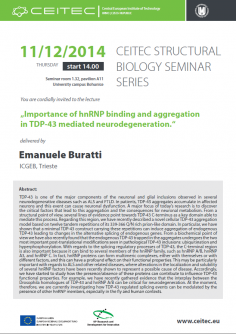Abstract:
TDP-43 is one of the major components of the neuronal and glial inclusions observed in several neurodegenerative diseases such as ALS and FTLD. In patients, TDP-43 aggregates accumulate in affected neurons and this event can cause neuronal dysfunction. A major focus of today’s research is to discover the critical factors that lead to this aggregation and the consequences for neuronal metabolism. From a structural point of view, several lines of evidence point towards TDP-43 C-terminus as a key domain able to mediate this process. Regarding this region, we have recently described a novel cellular TDP-43 aggregation model based on twelve tandem repetitions of its 339-366 Q/N rich prion-like domain. In particular, we have shown that a minimal TDP-43 construct carrying these repetitions can induce aggregation of endogenous TDP-43 leading to changes in the alternative splicing of endogenous genes. From a biochemical point of view we have also recently found that the endogenous TDP-43 trapped in the aggregates undergoes the two most important post-translational modifications seen in pathological TDP-43 inclusions: ubiquitination and hyperphosphorylation. With regards to the splicing regulatory processes of TDP-43, the C-terminal region is also important because it can bind to several members of the hnRNP family, such as hnRNP A/B, hnRNP A3, and hnRNP C. In fact, hnRNP proteins can form multimeric complexes, either with themselves or with different factors, and this can have a profound effect on their functional properties. This may be particularly important with regards to ALS and other related diseases, where alterations in the localization and solubility of several hnRNP factors have been recently shown to represent a possible cause of disease. Accordingly, we have started to study how the presence/absence of these proteins can contribute to influence TDP-43 functional properties. For example, we have recently gathered evidence that the interplay between the Drosophila homologues of TDP-43 and hnRNP A/B can be critical for neurodegeneration. At the moment, therefore, we are currently investigating how TDP-43 regulated splicing events can be modulated by the presence of other hnRNP members, especially in the fly and human contexts.








